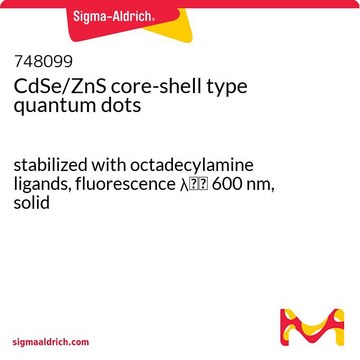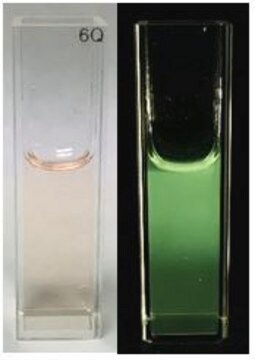776777
InP / ZnS量子点
stabilized with oleylamine ligands, fluorescence λem 620 nm, 5 mg/mL in toluene
同義詞:
Cadmium free core shell quantum dots, Cadmium free quantum dots, Core/Shell heavy metal free quantum dots, Fluorescent nanocrystals
About This Item
推薦產品
尋找類似的產品? 前往 產品比較指南
應用
and the corresponding regulations worldwide makes these InP/ZnS quantum dots as more desirable alternatives for consumer applications.
其他說明
訊號詞
Danger
危險分類
Aquatic Chronic 3 - Asp. Tox. 1 - Carc. 1B - Flam. Liq. 2 - Repr. 2 - Skin Irrit. 2 - STOT RE 1 - STOT RE 2 - STOT SE 3
標靶器官
Central nervous system, Lungs, Respiratory system
水污染物質分類(WGK)
WGK 3
閃點(°F)
closed cup
閃點(°C)
closed cup
客戶也查看了
文章
Since the first report of the low-cost dye-sensitized solar cell (DSSC) in 1991 by Gratzel and his coworker,1 dye-sensitized solar cells (DSSC) has been regarded as one of the most promising photovoltaic technologies because of their transparent and colorful characteristics, as well as low cost.
Since the first report of the low-cost dye-sensitized solar cell (DSSC) in 1991 by Gratzel and his coworker,1 dye-sensitized solar cells (DSSC) has been regarded as one of the most promising photovoltaic technologies because of their transparent and colorful characteristics, as well as low cost.
Professor Sharma and colleagues review the synthesis and applications of this novel material. This includes a discussion of the unique properties of quantum dots and their suitability for solar cell applications, along with common synthesis techniques used to develop these materials.
Professor Xiaohu Gao (University of Washington, USA) provides a overview of recent quantum dot (QD) advancements and their potential for advancing bioassay and bioimaging technologies.
我們的科學家團隊在所有研究領域都有豐富的經驗,包括生命科學、材料科學、化學合成、色譜、分析等.
聯絡技術服務









